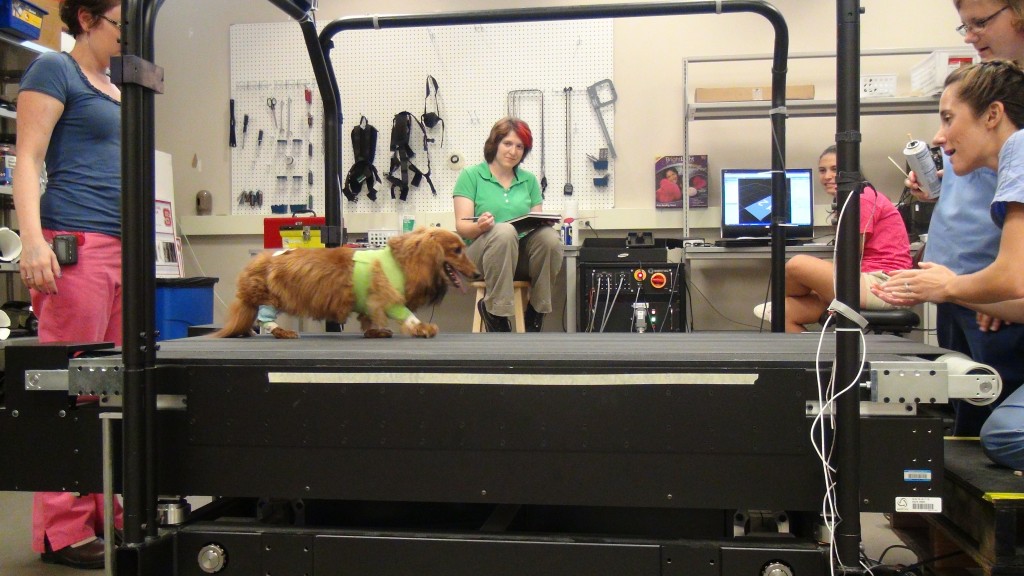Dachshunds on Treadmills—How I Spent My First Vet School Summer

Bert, a long-haired dachshund, takes his turn on the treadmill as a participant in Dr. Natasha Olby’s ongoing research that seeks to improve treatment techniques for dogs suffering from back injuries. Sarah Blau (center) monitors Bert’s activity.
Sarah Blau, a member of the Class of 2017 at NC State University’s College of Veterinary Medicine, is sharing some of what she learns and experiences as a second-year veterinary student with readers of the CVM News Central Blog. Watch for these postings on a monthly basis.
I spent my whole summer playing with dachshunds! Well, doing research and working hard too, but mostly, playing with dachshunds. I gush about my summer when friends I haven’t seen in ages ask me what I’ve been up to. I’ve gained a new perspective on veterinary research and acquired a soft spot in my heart for our stubby-legged, long-bodied canine friends. I am sad to see summer draw to an end.
I had given barely a thought to veterinary research when I learned last year about NC State’s Veterinary Scholars Program, a summer research internship available for first-and second-year veterinary students. The appealing offer of a significant stipend and a secure plan for my first summer convinced me to apply. I perused the list of available research topics and was delighted to find a few projects related to biomechanics (re-igniting my excitement for physics in veterinary medicine). Most notably, a study under Dr. Natasha Olby’s neurology lab caught my eye. It was looking at measuring center of pressure in dogs walking on a treadmill, how cool! Thankfully, the Veterinary Scholars Program selected me for the research position and a grant from the National Institutes of Health funded my summer work.

Summer research kicked off mid-May, and I was quickly immersed in a wonderful research team including Dr. Olby, members of her Canine Spinal Cord Injury Program, members of NC State’s Department of Biomedical Engineering (under Dr. Greg Sawicki), and two other students from my class who were selected for similar research projects. Our research subjects were “chondrodystrophoid” dogs—dogs like dachshunds or Pekingese that have short, stubby legs and disproportionately long bodies. These dogs are particularly prone to certain back injuries—much like a “slipped disc” in humans—that can damage their spinal cord and weaken their hind legs, sometimes to the point where they are completely immobile and cannot even feel pain!
Dr. Olby’s lab is constantly looking for ways to improve treatment techniques for dogs suffering from back injuries. In order to scientifically test new techniques, clinicians need a reliable scale for measuring recovery– enter our summer research projects! My project involved walking dogs on a specialized treadmill to see if their center of pressure as they walked could be used to measure recovery of injured dogs.
Throughout the summer we recruited healthy dogs from willing dog owners and brought them to the biomedical engineering department’s Human PoWeR (Physiology of Wearable Robotics) Laboratory. The treadmill there has a force-plate that measures center of pressure as the dog walks. Infrared sensors strung about the room could track reflectors that we placed on certain parts of the dog. This awesome technology, crossed-over from the human medicine realm, helped us develop a range for center of pressure variability in healthy chondrodystrophoid dogs. Future research will be able to use this normal dog range as a basis for comparison for dogs recovering from back surgery and/or other treatments.
The culmination of the summer scholars program took place at the 15th Annual Merial-NIH Veterinary Scholars Symposium at Cornell University in early August. I designed and presented my first-ever research poster at the symposium and marveled in wonder at all the other student research on display during the weekend. The theme of the symposium was One Health (hey, I’ve blogged about that!), and I was impressed by speakers like Dr. Barbara Netterson-Horowitz, author of Zoobiquity, and Dr. Kristy Richards, who studies cancer genetics at the University of North Carolina in partnership with the College of Veterinary Medicine’s own Dr. Steve Suter and Dr. Matthew Breen. Both Netterson-Horowitz and Richards are medical physicians who recognize the great impact that can be made by collaboration between human and animal medicine.
The real culmination of the summer research program, for me personally, occurred the Monday after I returned from the symposium. I got the chance to observe a back surgery on an injured dachshund. After all this research and work with healthy and recovering dogs, it was awe-inspiring to see the surgery: to see the resident neurologist ever-so-carefully removing disc material from the spinal canal, releasing pressure on the spinal cord, giving that dog the best chance it could have to walk again. As much as I enjoyed my summer research project, I wonder if surgery might be my calling. I supposed time and experience will tell as I venture earnestly into my second year of veterinary school.
[section_subtitle] For further reading: [/section_subtitle]
Putting Passion into Practice–The Human PoWeR Lab and canine spinal cord injuries

Information gained from healthy volunteer dogs such as Urchin will help the Canine Spinal Cord Program assist dogs suffering from back issues.


